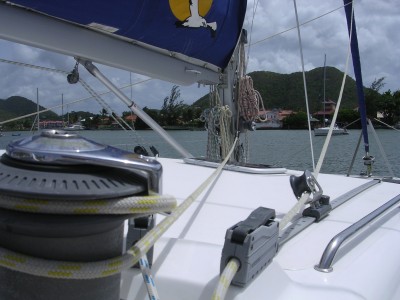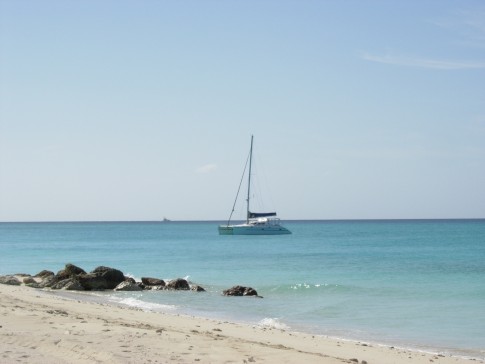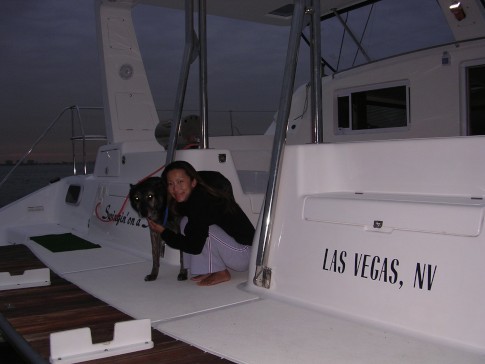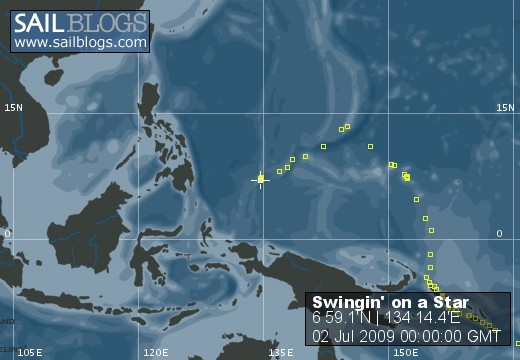
Swingin' on a Star
Ship's log for the circumnavigating Saint Francis 50 catamaran, "Swingin on a Star".
01 April 2010 | Palau
13 July 2009 | Palau
05 July 2009 | Yacht Harbor
03 July 2009 | Peleliu
02 July 2009 | Palau
01 July 2009 | Two Dog Beach
30 June 2009 | Mecharchar
29 June 2009 | Mecharchar
28 June 2009 | Ulong
27 June 2009 | Ngeruktabel
17 June 2009 | Ngeruktabel
16 June 2009 | Ngeruktabel
15 June 2009 | Ngeruktabel
14 June 2009 | Ngeruktabel
13 June 2009 | Ngerutable
25 May 2009 | Yacht Harbor
30 April 2009 | Malakal
29 April 2009 | Koror
28 April 2009 | Malakal
27 April 2009 | Malakal
Halyard Tune Up
05 June 2007 | Rigging Roundup
Randy

Every boat that we considered during our selection process had the option of bringing all of the sail controls back to the cockpit. Except the one we bought. Given that this safety feature was a very high priority for us you can guess how much we like everything else about the boat.
I had to go forward to put the second reef in during a squall with 35 knot sustained winds recently. No big deal to the old salts I'm sure. For my part, having to reef the main sail down with no luff line in big wind and seas from the fore deck is not my idea of fun. It is very hard to communicate with the helm in high winds from the fore deck and you are a lot more exposed which makes everything more difficult. If you're putting the second reef in you should probably be jacked in which complicates movement. It can also be difficult to make the reef point tack reach the clip if the sail doesn't come down flaked the way you want it. I have had to use a bit of line with a bolin on the reef tack to winch the ring down enough to clip in the tack.
Double handing means single handing much of the time and it would be great not to have to wake Hideko up every time I have to reef or shake one out. You just can't beat the comfort and safety of the cockpit for boat operations. Some say, "what if there's a problem at the mast, then you have to go forward anyway". True, but only then. The other 50 times you pull down the luff line while slipping the halyard, then bring in the leach line, tighten up the halyard and voila. All while staying nice and dry in the cockpit and having full control of the helm in case you get a big wave or whatever.
I had extensive discussions with the guys at FKG in Saint Martin about this matter and I believe that they are highly skilled riggers. Unfortunately their frank advice and my detailed examination of the options caused us to abandon the goal of bringing reefing capability to the cockpit at this juncture.
It would be complex to keep everything fair and I am guessing that the deck would need to be built up in areas where standing blocks, organizers and other hardware would end up. That said, the main set back was the rig itself. Our boat has three reef points with luff rings that clip in and leach lines that run through the boom to jammers at the mast end of the boom. Adding luff lines to bring to the cockpit was not something the current rig would accommodate easily. Switching to single line reefing would also require big changes. Defeated, temporarily, I fell back to an intermediate position.
To make reefing somewhat easier I had a reefing winch added to the back of the mast directly below the boom where the reef lines exit. Our boom originally had winches on port and starboard. The third winch has made the path for the leach lines much more fair than when running to the side mounted winches. It also allows me to leave the leach line on the winch which is nice because the boom jammers are hard to set under tension and not super reliable unless they have loaded up while set. The other benefit is that I can have the halyard on the starboard winch and I can use the port winch as a come-along to bring the reef cringle down to where I can clip it (another reason I'd prefer luff lines).
Our boat was designed to allow the windlass capstan to crank the halyard when raising the main. I'm not keen on the windlass solution for raising the main. The windlass is designed to haul rode and it burns the lines due to the capstan design and imperfect human tailing (perhaps I'm just not good at it). It is also hard to look down to keep the line from wrapping while also looking up to see that the battens are clear of the jacks and that none of the reef lines are tangled, etceteras. I don't like having the anchor locker hatch open if it is bumpy. Perhaps I'm biased but it just seems like another job that should be done from the cockpit.
After a short discussion with the riggers we came up with a simple solution. First we swapped the main halyard with the storm jib halyard. This put the main halyard on the helm side of the mast. Then we added an eye to the mast at a spot that would allow the halyard to lead fair back to the primary winch at the helm through a snatch block.
The main halyard is not living in the cockpit as I originally wanted but I now get 90% of the benefit. To raise the main I go forward and pull the sail up as far as possible by hand with the clutch closed (I can skip this bit if single handing in winds too tricky for the auto pilot). Then I clip the halyard into the snatch block on the new eye and bring the halyard back to the helm. I put the halyard on the self-tailing powered primary winch and press the button with my foot. This allows me to steer the boat with both hands, watch the sail with perfect visibility and let the winch do the work. When the sail is close to the top I bring the halyard tail forward, put it on the starboard mast winch and tighten it up leaving the halyard on the mast winch with the mast clutch closed. Perfect.
P.S. We've done 500 miles with this new rig setup and it is great. Previously if we were had an hour hop I would often motor even if the wind was good just because it was too much work to raise the main for such a short trip. I have used the windlass a few times but I think it is more hassel than it is worth, so I switched to the manual mast winch. This is hard work. Cats have heavy main sails with lots of roach, full battens and big square footage. The main is the power sail on most cats. Ours is 947 square feet. I never timed myself but it took quite a while to get the main all the way up the 73' above the water stick. If we just motored we'd be there.
Now we put the sails up every chance we get. Hideko can raise the main easily as well. Just go forward and grab the halyard, snap it in, bring it back, put it on the winch and press the button. You have great visibility and control of the boat so you don't typically get hung up when raising the main from the cockpit. The benefit has just emboldened me to continue to look for a way to bring all the lines back!
I had to go forward to put the second reef in during a squall with 35 knot sustained winds recently. No big deal to the old salts I'm sure. For my part, having to reef the main sail down with no luff line in big wind and seas from the fore deck is not my idea of fun. It is very hard to communicate with the helm in high winds from the fore deck and you are a lot more exposed which makes everything more difficult. If you're putting the second reef in you should probably be jacked in which complicates movement. It can also be difficult to make the reef point tack reach the clip if the sail doesn't come down flaked the way you want it. I have had to use a bit of line with a bolin on the reef tack to winch the ring down enough to clip in the tack.
Double handing means single handing much of the time and it would be great not to have to wake Hideko up every time I have to reef or shake one out. You just can't beat the comfort and safety of the cockpit for boat operations. Some say, "what if there's a problem at the mast, then you have to go forward anyway". True, but only then. The other 50 times you pull down the luff line while slipping the halyard, then bring in the leach line, tighten up the halyard and voila. All while staying nice and dry in the cockpit and having full control of the helm in case you get a big wave or whatever.
I had extensive discussions with the guys at FKG in Saint Martin about this matter and I believe that they are highly skilled riggers. Unfortunately their frank advice and my detailed examination of the options caused us to abandon the goal of bringing reefing capability to the cockpit at this juncture.
It would be complex to keep everything fair and I am guessing that the deck would need to be built up in areas where standing blocks, organizers and other hardware would end up. That said, the main set back was the rig itself. Our boat has three reef points with luff rings that clip in and leach lines that run through the boom to jammers at the mast end of the boom. Adding luff lines to bring to the cockpit was not something the current rig would accommodate easily. Switching to single line reefing would also require big changes. Defeated, temporarily, I fell back to an intermediate position.
To make reefing somewhat easier I had a reefing winch added to the back of the mast directly below the boom where the reef lines exit. Our boom originally had winches on port and starboard. The third winch has made the path for the leach lines much more fair than when running to the side mounted winches. It also allows me to leave the leach line on the winch which is nice because the boom jammers are hard to set under tension and not super reliable unless they have loaded up while set. The other benefit is that I can have the halyard on the starboard winch and I can use the port winch as a come-along to bring the reef cringle down to where I can clip it (another reason I'd prefer luff lines).
Our boat was designed to allow the windlass capstan to crank the halyard when raising the main. I'm not keen on the windlass solution for raising the main. The windlass is designed to haul rode and it burns the lines due to the capstan design and imperfect human tailing (perhaps I'm just not good at it). It is also hard to look down to keep the line from wrapping while also looking up to see that the battens are clear of the jacks and that none of the reef lines are tangled, etceteras. I don't like having the anchor locker hatch open if it is bumpy. Perhaps I'm biased but it just seems like another job that should be done from the cockpit.
After a short discussion with the riggers we came up with a simple solution. First we swapped the main halyard with the storm jib halyard. This put the main halyard on the helm side of the mast. Then we added an eye to the mast at a spot that would allow the halyard to lead fair back to the primary winch at the helm through a snatch block.
The main halyard is not living in the cockpit as I originally wanted but I now get 90% of the benefit. To raise the main I go forward and pull the sail up as far as possible by hand with the clutch closed (I can skip this bit if single handing in winds too tricky for the auto pilot). Then I clip the halyard into the snatch block on the new eye and bring the halyard back to the helm. I put the halyard on the self-tailing powered primary winch and press the button with my foot. This allows me to steer the boat with both hands, watch the sail with perfect visibility and let the winch do the work. When the sail is close to the top I bring the halyard tail forward, put it on the starboard mast winch and tighten it up leaving the halyard on the mast winch with the mast clutch closed. Perfect.
P.S. We've done 500 miles with this new rig setup and it is great. Previously if we were had an hour hop I would often motor even if the wind was good just because it was too much work to raise the main for such a short trip. I have used the windlass a few times but I think it is more hassel than it is worth, so I switched to the manual mast winch. This is hard work. Cats have heavy main sails with lots of roach, full battens and big square footage. The main is the power sail on most cats. Ours is 947 square feet. I never timed myself but it took quite a while to get the main all the way up the 73' above the water stick. If we just motored we'd be there.
Now we put the sails up every chance we get. Hideko can raise the main easily as well. Just go forward and grab the halyard, snap it in, bring it back, put it on the winch and press the button. You have great visibility and control of the boat so you don't typically get hung up when raising the main from the cockpit. The benefit has just emboldened me to continue to look for a way to bring all the lines back!
Comments
| Vessel Name: | Swingin' on a Star |
| Vessel Make/Model: | Saint Francis 50 |
| Hailing Port: | Las Vegas, NV |
| Crew: | Randy Abernethy |
| Home Page: | http://swinginonastar.com |
Swingin on a Star

Who: Randy Abernethy
Port: Las Vegas, NV






